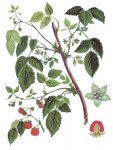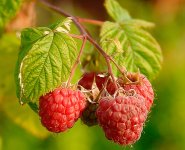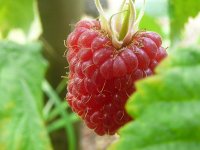Raspberry
Rubus idaeus L.
Botanical characteristics. Family rose-colored. The shrub is 1-3 m high, prickly, branchy. Has shoots of the first and second years. The leaves are dark green at the top, whitish underneath, pubescent, paranormous. White small flowers in the axils of the leaves are collected in racemose inflorescences. Blossoms in June-July. Fruits - red drupes of globose or oblong form, ripen in July-August.
Spread. Wild raspberries are found almost throughout the whole territory of our country, growing on the shores of water bodies, on forest edges, among bushes. It has long been cultivated in gardens as a beautiful fruit and berry plant.
Used parts of the plant.
Leaves and berries.
Raspberry berries contain acids: lemon, caproic, formic, malic, ascorbic (up to 45mg%), a little B vitamins, sucrose, fructose, cyanidin chloride, benzaldehyde and tannins.
Application.
Raspberries are a good diaphoretic and are used in the form of infusion in acute colds, enter into various sweatshops. Along with the fruits for the same indications are used and leaves of raspberries.
Fruits and raspberry leaves are added as vitamin and taste-improving additives.
As a soothing raspberry is used for neurasthenia and neuroses, as an astringent and hemostatic - with diarrhea and bleeding. Fruits and leaves of raspberries improve metabolism and find use in hypertension and atherosclerosis.
Fresh raspberries in folk medicine are used as a sobering remedy for intoxication. Leaves and berries are recommended for hypermenorrhea, hemorrhoids and skin rashes.
Externally, the infusion of leaves is used to rinse the throat and mouth cavity; For washing - with acne and rashes, with erysipelas and spring conjunctivitis.
Contraindications. Individual intolerance to raspberries.
Preparation.
2-3 tablespoons of berries or leaves are insisted with 2 cups of boiling water (daily dose).
The same infusion is used as an external agent.





Comments
When commenting on, remember that the content and tone of your message can hurt the feelings of real people, show respect and tolerance to your interlocutors even if you do not share their opinion, your behavior in the conditions of freedom of expression and anonymity provided by the Internet, changes Not only virtual, but also the real world. All comments are hidden from the index, spam is controlled.